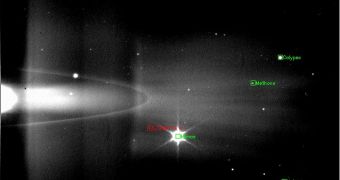Saturn is a curious planet, not because it's a gas giant, the second largest planet in the solar system, or because of the fact that its equatorial and polar diameters differ by almost 10%. The most interesting aspect of this giant is the number of satellites.
People often enjoy gazing at the Moon, our only natural satellite that inspired so many poems, love stories and movies. But what would it be like to look at sixty moons? Astronomers just announced that they discovered the 60th satellite of Saturn, a small celestial object in a wide orbit.
Jupiter may be the champion at gathering satellites, with 63 of them, but Saturn could soon overthrow the king, with this new appearance. Cassini space probe sent home new images of a tiny new moon, called S/2007 S4, but lovingly dubbed "Frank". The name will soon change, as the International Astronomical Union will soon agree on an official one, most likely taken from the Greek mythology.
Numbers seem not to be as important for astronomers as the chemical make up and the behavior of the new satellite, as even the smallest natural satellite can offer a great deal of information about cosmic processes.
"The big questions are always about the formation," the University of Hawaii's David Jewitt, one of the leaders of the Hawaii Irregular Satellites Survey, explained to MSNBC.com science editor Alan Boyle. "If you're not just butterfly-collecting, then you're answering questions about the way the solar system came to be."
Located near Mymas, Methone and Pallene, three other satellites of Saturn, Frank looks like a tiny speck in space just barely finding a free orbit in the busy circular highway around the giant planet. It is estimated to be about 1.2 miles (2 kilometers) and most probably made of rock and ice.
"With these new data sets we were able to establish a good orbit for the new moon," Carl Murray, a member of the imaging team from Queen Mary, University of London, said in a NASA statement on the discovery. "Knowing where the moons are at all times is important to the Cassini mission for several reasons."
For now, it seems that the only reason Frank is so important is because it's another object Cassini mission officials have to take into consideration when plotting the probe's future orbit.

 14 DAY TRIAL //
14 DAY TRIAL //